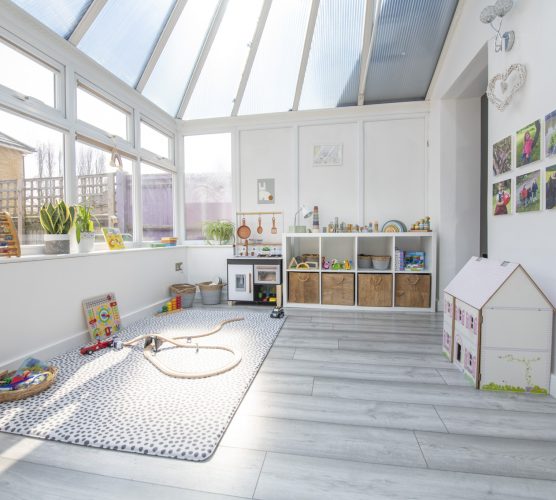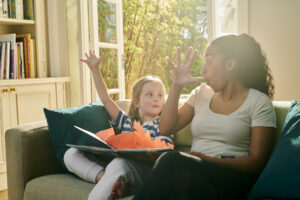The 2023 spring budget announced a £1,200 bonus for new childminders joining childminder agencies.
Thinking of setting up as a childminder? This guide will help you to turn your home into a successful childminding setting, while still making it feel like your home.
We’ll cover the Ofsted guidelines for childminding houses that you’ll need to comply with, but also the tips and tricks that aren’t so easy to find on Google.
Or learn more about becoming a childminder here.
Here’s what we recommend:
Hallway: a warm welcome
When you set up as a childminder, your hallway will be where parents spend their time when picking up and dropping off.
Keep your hallway as clean and clutter-free as possible.
- Tidy away excess coats, bags and shoes you don’t use every day
- Remove any items that don’t live here and store them away e.g. bikes
Hang a notice board where you can pin things for parents to see.
- Weekly menus
- Certificates and policies
- Themed displays of the children’s drawings and pictures of their big moments
Create a space for the children’s personal items.
- Each child will need a peg to hang their coats and bag
- Each child will need a box for indoor items like dummies, sleeping bags, toothbrushes and comforters
Kitchen: a fun and safe creation station
Whether your kitchen is big or small, it will be a great place to involve children in cooking and messy play.
Make creative play easy with a messy zone.
- A low table with little chairs as a play-zone, keeping things like playdough away from the carpets, and can double up as dining table at meal times
- A tuff tray allows you to set up sensory activities in advance for the children, and is a great place for paint or water-based activities
Kitchens can be dangerous even for adults, so take extra care. The following items should be kept high up, or in locked cupboards:
- Knives, scissors, glasses and breakable bowls
- Chemicals like bleach, sprays and detergents
- Dishwasher tablets and powders should also be out of reach
If they can’t sit at a low table, seat children in high-chairs and tuck in together to encourage healthy eating habits. Never leave children in the kitchen: even little ones crawl quickly! Lots of childminders add a stairgate to the door to the kitchen to prevent children getting in there on their own.
Bathroom: hygiene for little bottoms and first aid haven
If you have gone through a course to become qualified as a childminder, you will be prepared for those small emergencies that are bound to happen, but you must know where you keep the first aid kit so you can get to it quickly and have everything you need.
Looking after little children, you will need some extra bits in here:
- Changing table, or mat so you can change safely on the floor
- Nappies, wipes, and barrier creams
- Potty or toilet adaptor seat
Some parents will want you to use certain brands of nappies or creams, so leave a little extra room for those items. Above all, keep any medications locked away where children can’t reach them.
Bedroom: safe snoozing for little dreamers
The bedroom needs to be kept between 16-20°C for safe sleeping: cool but comfy. Small babies have a hard time regulating their own body temperature, so it’s important that they don’t get overheated because of too much clothing, bedding, or a warm room.
For a good nap, make sure you have:
- Cots or mats, depending on the child’s age
- Mattresses with a waterproof layer and fitted sheets
- Blankets tucked in safely, or sleep bags that fit
- A room-thermometer
- A baby-monitor (some come with thermometers)
Bedding needs to be safe too: don’t use pillows, and make sure blankets are tucked in and no higher than shoulder-height. Light can ruin a good nap, so use black-out blinds, heavy curtains, or double up to shut out as much light as possible. Safe sleeping is really important, so read more about guidelines here.
Play-area: toys and room for growing minds
When you set up your home nursery, Ofsted childminder house requirements mean you will need 2-3.5 square metres of space for every child, depending on their age. Don’t fill all that space with toys: it will get expensive fast, and children need room to move.
Pick toys with care and think of ‘open-ended’ play that lets children use their imagination and fine motor skills in a natural way.
- Stackable toys
- Duplo blocks
- ‘Small worlds’ (Farm, Garage, Cafe etc.)
- Lacing beads
- Shape sorters
- Soft dolls and teddies
- Books, books, and more books
Use rugs and low furniture to create different zones: a quiet corner with floor-cushions and boxes of books creates an inviting place for story-time at one end of the living room, while the other end can be an active area with blocks and cars.
Make sure the toys are good quality, that you have more than one of key toys (e.g. cars, dolls or teddies) so children don’t have to fight over the same toy, and rotate toys you have out to keep clutter to a minimum. Wooden toys are more eco-friendly and well-liked by parents, so get those when you can.
Organised storage (such as labelled boxes) will make it easy for you to clear the mess up, giving you your home back in the evenings, and saving time when you set up activities for the following day. Make it fun for children to help you tidy up with a tidy-up song encouraging them to sort and organise which is great for their development. They’ll also learn where to find things for themselves.
If you can, try to keep your TV separate from the main play area and secure it to a wall or table (so it can’t topple), then cover it with a blanket or shawl, and save it for your own time in the evenings. Children often get too much screen-time, but if they are busy with open-ended play and being outdoors, the television won’t be necessary.
Garden: fresh air and exploration
Not every home will have a garden, but if you do, it’s a wonderful space to let children explore, even when you return from your outdoor adventures away from home.
Gardens are great for messy play and active toys like:
- Mud kitchens (check out Pinterest for great DIY options)
- Sand pits
- Water tables
- Balls and soft/light ‘sporting equipment’
- Tricycles (with helmets and supervision)
Always keep an eye on little explorers, even in your own walled garden: they are only too happy to munch away on the odd bug and flower, and those are not the kind of ‘natural ingredients’ you want in tiny tummies!
Even a small balcony or backyard can be made into a useful extension of your play area. Consider adding chalkboards to the wall for mark making, laying fake grass as a play space, or putting a tuff tray out there for messy play. You’re bound to be able to squeeze in a small tub or window box to do a bit of growing too!
Your home, and their development
Every area of your home can be a great space for children to grow and learn: you just need to sit back and plan out situations during a typical day as a childminder before you start setting up your home. When you are thinking about what will be safe and fun for children, role-play and get down on the floor. What can you reach, what can you knock over, bump into, pull, push, stick your fingers in… And what can you play with?
Don’t get overwhelmed by all the preparations. We know there is a lot to think about, and the points above just scratch the surface of what we share with childminders who work with us when we help them set up their home.
The most important thing is that your home is a great place for children to play independently and safely, explore, and learn, with you as their caring grown-up. And remember, it’s still your home at the end of the day. It’s just a home that you share with the amazing little people you are helping grow into kind, curious children and bright adults, ready to face a world of change.



